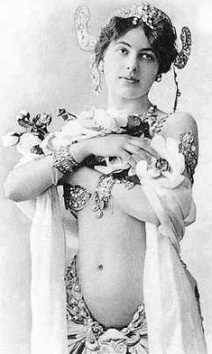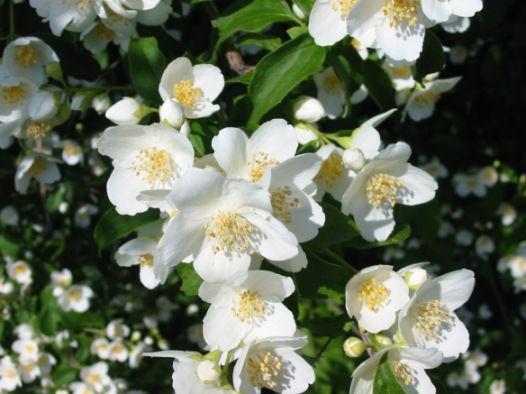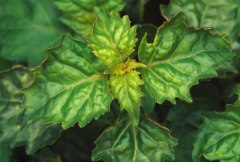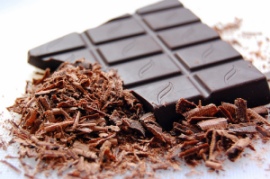The hedonistic excesses of Imperial Rome; the fleshiness of heaving white bosoms; Mata Hari in flowers as she dances to seduce; the wild rambunctiousness of the French cancan at the height of the 19th-century Moulin Rouge; the flashing of the frilliest of white knickers; and pure skank that finally subsides to a creamy, honeyed whisper — these are not the things that you’d expect to imagine from a fragrance that is meant to evoke the holiest of spiritual aromas. Yet, those are the things that came to mind when I tried Tawaf. It is a fragrance that blew my socks off while it lasted, a jasmine lover’s dream perfume in many ways, and the worst nightmare of anyone who hates indolic scents. God, it’s glorious. If only… well, we’ll get to that part eventually.
Tawaf is a 2012 eau de parfum from the highly respected French perfumer, Dominique Dubrana, who also goes by the name “Abdes Salaam Attar.” His Italian perfume house, La Via del Profumo, creates all-natural fragrances. They are so bold, intense, rich, and concentrated in feel that it’s hard to believe they are all natural, but Mr. Dubrana is a bit of a wizard. Many of his fragrances have a Middle Eastern flair, subtext, or inspiration, and this is especially true for Tawaf. The perfume is the last in his “Arabian Series” of fragrances, and is meant to be the olfactory “melody” of the most sacred scents at the heart of Mecca.
As AbdesSalaam Attar explains on his Profumo website, the name “Tawaf” refers to the ritual of pilgrims circling the sacred Kaaba (or Ka’abah) building in Mecca. He calls the Ka’abah “the geographic center of the Arabian soul,” so he sought to create a fragrance that was the “melody” of the scents surrounding the pilgrims:
the trails of Jasmine Sambac that pilgrims wear, the rose water poured from buckets to wash the white marble floor and the Oppoponax attar spread by the handful over the corners of the Ka’abah. These are the essences that comprise the new fragrance. [¶] Other ingredients meaningful in the Arabic tradition are Narcissus and Myrrh.
The perfume is binary in structure, with a Jasmine accord intertwining with an Oppoponax accord in the same way those chinese silk fabrics display two different colours depending on how the light shines on them.
The following is the succinct list of notes:
Jasmine sambac, rose water, opoponax [sweet myrrh], myrrh, and narcissus [daffodil].
I am clearly a heathen who is going to hell because Tawaf didn’t evoke anything spiritual or pure in my mind. In fact, quite the opposite. For me, its opening was pure, raw sensuality, carnality, and hedonistic excess — times a hundred. This is Mata Hari‘s jasmine, a scent born to seduce some, and kill others.
To understand that, you have to understand the essence of a flower like jasmine when it is taken to the extreme heights that it is here. The jasmine in Tawaf feels like the fleshiest of white flowers, with a syrupy sweetness and meatiness that is so opulently intense that it is truly quite narcotic. It’s brawny, potent, heady, meaty, indolent, and addictively sniffable for those who love jasmine, but the living nightmare of those who don’t.
In fact, the carnality of the note in Tawaf reminds me of the quote that the famous nose, Roja Dove, once said about tuberose (in the context of the legendary white floral powerhouse, Fracas):
tuberose is the most carnal of the floral notes. It smells like very, very hot flesh after you’ve had sex — that’s the bottom line. [via The Independent, 12/14/2002.] [Emphasis added.]
I think the same can be said of jasmine, especially when it is amplified to the extent that it is here. And, good God, is there jasmine in Tawaf. It explodes on the skin with such richness that it left my jaw rather agape. (In case you haven’t gathered by now, I love my jasmine.)
The other thing that Tawaf opens with is indoles. All white flowers have them, primarily for the evolutionary purpose of attracting bees who can’t see colourless florals. In their most concentrated, purest form, indoles can smell like musty mothballs and thereby act as a signal flare to the bees. However, when diluted to just a few drops in floral perfumes, they create a radiant richness that is often described as narcotic, heady, dense, voluptuous or sensuous. Unfortunately, on some people’s skin, very indolic flowers can take on an over-blown, ripe quality that occasionally smells sour, plastic-y, fecal, urinous, or reminiscent of a cat’s litter box. Its richness in classic, very opulent floral fragrances is probably why some people find indolic fragrances to smell “old lady-ish.” Those who prefer clean, fresh scents are also likely to struggle with indolic fragrances, and not only because of their heavy feel.
Tawaf opens on my skin with the fleshiest, most opulent, over-the-top jasmine that I’ve ever encountered, followed by indoles that manifest both their ripe, overblown side and their skank. Tawaf has a definite dirty factor that appears within minutes on the skin. At first, it’s only a subtle whisper of something a bit urinous, but it only takes 20 minutes for Tawaf to demonstrate almost a civet-like feral growl.
In the opening minutes, there is also a rubbery darkness underlying the intense white flowers that makes it feel as though they had been tinged with something black. It’s almost tarry and mentholated in a way, though never to the extent that Serge Lutens managed to do to jasmine’s white sister, tuberose, with Tubereuse Criminelle. Here, it never evokes diesel or iced menthol, but there is a definite undertone of something rubbery, dark, and almost smoky. It helps to cut through some of the jasmine’s bubble-gum sweetness, though there is still quite a lot of it that remains.
The overall effect feels wickedly naughty and voluptuous. If ever a jasmine were so fleshy that it amounted to a courtesan’s pillowy breasts heaving above the top of a tight corset, it would be Tawaf. There is a decadent excessiveness, overt carnality, and lush ripeness that positively oozes fleshiness. The white togated courtesans of Nero’s Rome would have drowned themselves in Tawaf while the city burned and he fiddled. And it definitely feels like the perfect scent for one of the greatest seductresses of all time, Mata Hari. Tawaf is simply super-charged jasmine on steroids — and I can’t get enough of it.
Twenty minutes in, the dirty skank factor moves from a quiet, muffled “meow” to a rather exuberant yell. I suddenly feel like someone in the 1890s Moulin Rouge who just had one of the Cancan dancers flash me her frothy white bloomers. No, truly, the indolic jasmine is like a chorus line of dancers as they rev up and go full throttle, kicking up their legs higher and faster with every minute.
In the midst of all this wild abandon, there are the tiniest whiffs of other elements. The least of them is the daffodil’s fresh sweetness that lurks in the sidelines, but for the longest time, I thought it was a figment of my imagination. It still might be. Whatever that vaguely fresh note may be, it simply can’t compete with all that bouncy Cancan. Slightly more noticeable is the sweet myrrh, which initially comes across more like cinnamon than the traditional nutty way that opoponax shows itself on my skin. Regardless, it is extremely muted, and also bears little chance of competing with the powerhouse white florals on center stage. Tawaf’s jasmine is as dense as a solid gold brick, and its initial projection is about 3 inches with 2 medium smears, but about 4-5 inches with a greater quantity.
Alas, 45 minutes in, the wonderful madness winds down, and the frothy, skanky knickers collapse in an exhausted, subdued heap on the floor. The jasmine loses much of its opulent, dirty richness as Tawaf becomes a skin scent. It’s now a light, sweet jasmine touch with a drop in its dirty, rubbery, dark undertones. It’s still lushly white and narcotic, but Tawaf is much less blowsy and not as ostentatious. My skin never has much luck in holding onto jasmine soliflores. For example, my skin ate through another jasmine soliflore, Serge Lutens‘ fantastic A La Nuit, with even greater rapidity.
Speaking of which, I once read that A La Nuit was considered to be “death by jasmine,” but I think Tawaf makes the Lutens look like child’s play in comparison. Tawaf feels a hundred times more concentrated and dense than A La Nuit, which would make the Dubrana version my ideal if it retained its projection for several more hours. As an all-natural fragrance, I realise that is extremely difficult to do, especially for a floral scent. Still, I’m rather crushed, as Tawaf’s opening salvo is truly spectacular.
Tawaf slowly begins to change about 75 minutes into its development. The sweet myrrh finally appears properly, adding a nutty warmth and sweetness, while the (regular) myrrh provides the faintest hint of dustiness. They are both incredibly subtle, however, and their main effect is to turn Tawaf more golden, less white and sweet. Half an hour later, the sweet myrrh kicks into high gear, smelling like the smoothest of mild, white honey or honeyed wax. It coats the skin like the thinnest of layers, and starts to vie with the jasmine for dominance.
About 2.75 hours in, Tawaf becomes an extremely creamy, delicately soft, vaguely floral, honeyed beeswax, and it remains that way until its very end. All in all, Tawaf lasted 6.25 hours on my skin, with occasional small patches continue to radiate out the scent if I really rooted at my arm ferociously. It had the shortest longevity out of all the Profumo scents that I’ve tried thus far, which had previously given me 10 hours or more. None of them were pure florals, though, and my skin can be particularly bad with those, even when they aren’t all-natural perfumes.
The Non-Blonde had almost the identical experience that I did with Tawaf. Her review reads, in part, as follows:
Smelling Tawaf from La Via del Profumo for the first time can be shocking. If there ever was a “Death by Jasmine” perfume this is it. Tawaf, religious and spiritual back story aside, is as dirty and indolic as they come. […] Tawaf is very much about jasmine- real and raw, even when it’s softened and tempered with a cream-to-powder opoponax. […][¶]
Once you can smell and breathe beyond the heady jasmine garlands that seem to have landed around your neck, there’s more to explore. The jasmine becomes smoother and beautifully honeyed. That’s where my doubts disappear and I fall in love again and again. Opoponax is usually pretty resinous, but here it emerges from the honey with a very creamy feel that dries down fairly quickly into a slightly woody powder that complements and grounds the jasmine just a little: it’s still heady and golden, but the way the note responds to skin is warm and highly satisfying.
Tawaf remains detectable for five to six hours, though its projection is rather low and there’s little sillage once the initial blast is gone. While jasmine is considered a mostly feminine note in Western perfumery, there’s nothing girly or womanly in this fragrance. Tawaf is atmospheric, so men who aren’t afraid of jasmine should give it a chance and see what happens when they go there.
She also adds something else that I agree with wholeheartedly:
In my opinion [Dominique Dubrana is] one of the most fascinating perfumers working today; well worth the minor hassle of ordering samples from his website (profumo.it).
The Non-Blonde didn’t fall in love from first sniff, but she definitely did by the end because of the drydown. It’s true, the honeyed creaminess is very appealing, even if it is excessively discreet. Another thing with which I agree is that men who aren’t afraid of jasmine should try it.
If you don’t think a guy can or should wear jasmine, you better not tell that to Kevin of Now Smell This who barely restrains himself from saying that he LOVES (in all caps, no less) Tawaf:
Tawaf is composed of beautiful, strong aromas*: a vibrant floral accord of jasmine and rose (sweet, syrupy and possessing an indolic punch); a note that reminds me of musky, honey-drenched hay (no, I’ve never encountered honey-drenched hay in person, just in my imagination); warm opopanax; and buzzing, floral amber — clear and pungent, but not too “clean” (is that a bit of patchouli I smell?) Tawaf’s opening comes close to duplicating one of the most mesmerizing floral scents: the powerhouse perfume of blossoming Cestrum nocturnum (gardeners: if you love flowers that can scent an entire block, investigate this plant). As Tawaf dries down, it becomes sheer with hints of honeycomb, myrrh and residual floral notes.
I try to avoid hyperbole in describing my attraction to perfumes (how can I ‘LOVE’ a non-living thing?); let’s say I ‘adore’ Tawaf. Though I’ve enjoyed all La Via del Profumo Arabian series perfumes, Tawaf is my favorite. One spritz of Tawaf goes a long way…for a short time (two hours); if you’d like the fragrance to extend to three or four hours, apply more perfume in the first place but expect to scent a HUGE space with your sillage. On the masculine-feminine “scale,” Tawaf veers more towards feminine perfume territory, but if you’re the type of man who has no problem with heady florals, go for it.
Oh, Kevin, just say you love it. We can rock our Tawaf together, preferably with more than one spritz, even if the amplified result ends up killing all the jasmine-phobes who come close.
Speaking of those who are usually rendered ill by jasmine fragrances, the sole review for Tawaf on Fragrantica comes from someone who seems to make an exception for the Profumo version. “Lilybelle911” writes:
This is a lovely jasmine fragrance. It does not make my stomach feel queasy as some jasmine scents do. I received a generous decant as part of a sampling group, and I have a spritz now and then when I am in the mood for its serene beauty, when no mass market perfume will suffice to soothe and inspire. I have been fortunate to sample quite a few Via del Profumo fragrances, and they never fail to have a pronounced effect upon my psyche and sense of well being. They are not only very well composed perfumes, but have aromatherapy benefits as well. I highly recommend this line of perfumes. Mr. Durbano is blessed with a rare gift.
I’m thoroughly glad she enjoyed it, but I still wouldn’t recommend Tawaf to anyone who doesn’t wholeheartedly love indolic white flowers. “Death by Jasmine” may be a wonderful way for me to go, but I don’t think others may be so sanguine.
Tawaf bears what I’m starting to realise is a distinct Profumo signature: bold intensity in the opening. Mr. Dubrana doesn’t seem to do anything by half-measures — God bless him — and that intensity is a joy for someone who likes the note(s) in question. It’s not as easy if you’re ambivalent, no matter how soft, whispering and lovely the subsequent drydown may be. So Tawaf may be best for those who enjoy the most opulent of narcotic, white flower bombs, along with a little dirty skank.
In short, if you’re a jasmine lover, you really must try Tawaf. It is moderately priced at $63 (or roughly €56 with VAT) for the smallest bottle, samples aren’t difficult to obtain, and I think it will make your head spin in the best way possible. The discreet sillage and reduced longevity are the only drawbacks to what may be the ultimate jasmine perfume. In spite of those flaws, I still think that Tawaf is worth testing, especially for that monumental opening. It takes decadent excess and seductiveness to an extent that would make even Mata Hari sit up and blink.
Disclosure: My sample was courtesy of AbdesSalaam Attar. That did not impact this review. I do not do paid reviews, my views are my own, and my first obligation is honesty to my readers.











































